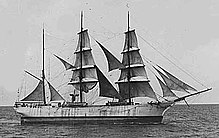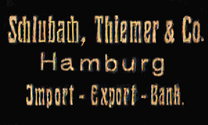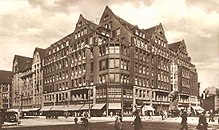Schlubach & Co.
| Schlubach & Co.
|
|
|---|---|
| legal form | Limited partnership |
| founding | 1867 |
| resolution | June 1, 2001 |
| Seat | Hamburg |
| Branch | Import, export, bank |
Schlubach & Co. was an international trading company in Hamburg , which existed from 1867 to 2001.
history
1856–1914: The rise of Heinrich A. Schlubach in Chile and Guatemala
In 1856, the 20-year-old Heinrich August Schlubach sailed alone and without fortune on a small barque around Cape Horn to Valparaíso and settled there as a merchant . After extensive deposits of saltpeter and guano , which were valuable raw materials for the manufacture of fertilizers and explosives, were found in the region in Chile in the 1860s , he quickly made great fortunes and founded the import and export company Schlubach & Co. in 1867. in Hamburg. He married Margaret Brander, a daughter of the wealthy Scottish merchant John Brander (1817–1877). Her mother Titaua Brander was the daughter of the English merchant Alexander Salmon (1822–1866) and his wife Oeahu Arriitamai, who in turn was a daughter of Queen Pomaré IV of Tahiti . The Brander and Salmon families owned extensive coconut plantations in Tahiti, the Marquesas Islands, and the Cook Islands . In addition, they have been running a large sheep breeding farm for export wool on Easter Island since 1866 .

In 1882 Heinrich Schlubach and his partner Otto Thiemer (1856–1916), who had been won in the meantime, sold their trading company in Chile for 22 million gold marks to the GAHörmann company in Valparaiso and returned to Hamburg, where they now worked with the capital under the Schlubach, Thiemer & Co . started new business. So in 1889 they founded the " Guatemala Plantagen Society " with other Hamburg merchants . They acquired over 15 coffee plantations and a processing mill in Guatemala . Among them was the finca "El Pensamiento", which had previously belonged to the former President of Guatemala, Manuel Lisandro Barillas Bercián , and who had fled into exile in Mexico in 1898 under his successor Manuel José Estrada Cabrera . The plantations produced around 5,000 sacks of coffee in 1901/02. There was a setback when, in 1902, when the volcano Santa María erupted, the fincas " El Pensamiento " and " El Bolivar " were covered with ash over two meters high. Schlubach then restructured the companies in Guatemala, founded the subsidiary " Schlubach, Dauch & Co " together with the German businessman Walther Dauch and hired the coffee expert David Sapper. Coffee production increased to 20,000 sacks in 1908/09.
In 1911, the parent company “ Schlubach, Thiemer & Co. ” moved into new offices in the Südseehaus on Mönckebergstrasse , corner of Lange Mühren 9-11, and was one of Hamburg's leading foreign trade companies. She sold entire industrial plants to South and Central America, mainly breweries and mills, but also special machines for agriculture. With the coffee and other colonial goods imported in return, she supplied both wholesalers and small Hamburg shops. Since 1911, the company has also participated in the raw cocoa trade with Ecuador and Colombia . In 1914 it also took over other coffee plantations in Guatemala and now produced over 32,000 sacks of coffee under the company “ Central American Plantation Company” .
1914–1931: "Schlubach, Thiemer & Co." between world war and banking crisis
After Heinrich Schlubach's death on June 12, 1914, Walther Dauch became chief executive. In addition, Schlubach's sons Eric (July 25, 1878; † October 20, 1962), Roderich (* April 1, 1880; † October 24, 1953) and Hermann Edgar (* May 5, 1882; † February 11, 1928) were as Shareholder in leading positions. During the First World War , Eric Schlubach served as a corvette captain in the Imperial Navy from 1914 to 1918 . In 1920 Walther Dauch was elected to the German Reichstag for the DVP . Eric and Roderich Schlubach, on the other hand, joined the DNVP , for which Eric was a member of the Hamburg parliament from 1924 to 1927 .
In May 1921 Schlubach, Thiemer & Co., together with Deutsche Aero-Lloyd and others, took part in the founding of the “ Condor ” syndicate , from which Deutsche Lufthansa emerged five years later .
In the following years Schlubach, Thiemer & Co. were also involved in the production and import of tropical fruits in Africa . They participated in the African Fruit Compagnie (AFC) and in 1925 bought the approx. 5900 hectare “ Likomba ” plantation in Cameroon . For the transport of the bananas, together with AFC, they started building transport ships that were equipped with cooling facilities.
In 1928 an engagement followed in Argentina . The " Compañia de Venta de Hierros Aceros Europeos " was founded with the company Felten & Guilleaume , Cologne, and land was bought up. In the same year Hermann Edgar Schlubach died and left four children, including the future architect Geert Edgar Schlubach and Jan Schlubach, who later became known as a stage designer .
The Great Depression of 1929 had devastating consequences for the company, which had financed its business to a large extent with foreign, especially British, capital. As a result of the 1930 Reichstag elections , Brüning's emergency ordinances and a feared insolvency of the Reich, the loans were not extended. On June 11, 1931, at the height of the German banking crisis , Schlubach, Thiemer & Co finally became insolvent and had to file for bankruptcy.
1931–2001: After bankruptcy until takeover by KD Feddersen
In 1936 Schlubach & Co. reappeared as a participant in a consortium under the supervision of Roderich Schlubach to take over the Debundscha planting (DKG) founded by the Swede Linell in Cameroon at the end of the 1880s . In 1938 the company owned a total of 1,800 hectares, of which 388 hectares were planted with banana trees and 110 hectares with oil palms.
After the death of Roderich in 1953 and Eric in 1962, their sons continued the company in the third generation.
In 1983 Schlubach & Co. took over the companies of BOCHAKO Chemie-und-Technik-GmbH, founded in 1951, which were active in trade with Russia and other Eastern European countries.
In 1992 Schlubach & Co. were taken over by KD Feddersen Holding GmbH (KDF) and complements the range of services of the association in the import and export sector. Two years later Schlubach & Co appeared on the import lists for mercury of the Brazilian foreign trade authority. The poisonous mercury was used for gold mining in the Amazon. At a press conference in Santarém , the mercury contamination was denounced by Greenpeace . Schlubach & Co denied any involvement in the business. In 1997, the Schlubach individual companies were finally merged to form Schlubach & Co. Handels- und Bochako GmbH. As a result, the trading activities in Russia , some former CIS countries and South America were combined in one company. The product portfolio consists of fine and industrial chemicals as well as various specialties on the one hand, and systems and machines and their spare parts on the other.
Since June 1, 2001, business has been carried out under the company KD Feddersen & Co Ueberseegesellschaft mbH.
Cultural and scientific commitment
In 1882, during the German Easter Island expedition of the ship SMS Hyäne under captain Wilhelm Geiseler, Heinrich Schlubach, at the request of Adolf Bastian , who was then director of the Royal Museum of Ethnology in Berlin , brokered the acquisition of several Rongorongo tablets . The three tablets M, N and O were given to the uncle of Schlubach's wife, Alexander Salmon Jr., who then sent them to Schlubach. When Schlubach returned to Hamburg in 1883, he sent the tablet O to Bastian in Berlin. It is still in the Ethnological Museum today. Schlubach privately sold the M and N tables to the Hamburg company “Klee und Kocher”, which they resold to the Austrian Vice-Consul Heinrich Freiherr von Westenholz. He donated it to the Museum für Völkerkunde Wien in 1886 .
1903–1905, Eric Schlubach traveled to China , Korea , Japan and Siberia as a young naval officer in the East Asian Squadron of the Imperial Navy . He published his descriptions and watercolors in 1958 as a book under the title " Travel Letters from the Far East" . They provide an impressive picture of the nature and culture of the countries shortly after the Boxer Rebellion was put down.
In 1922, Hermann Edgar Schlubach and the young London businessman Henry Frederick Tiarks supported a Dutch-German solar eclipse expedition to the Christmas Islands . As a thank you, the asteroid 922 " SchluTia ", discovered by Karl Wilhelm Reinmuth in Heidelberg on September 18, 1919, was named in her honor .
In 1923 the Schlubach family supported the establishment of an institute for American studies at the University of Würzburg . Financial support included a. 1923-1924 a two-year research trip by the geographer and ethnologist Karl Sapper (cousin of her former colleague David Sapper) through Mexico , Central America , Colombia and Venezuela and 1925-1929 a four-year research trip by the ethnologist Franz Termer (successor of Sapper), which also led through Central America. The University of Würzburg then made Roderich and Herbert Schlubach its honorary members .
literature
- Dieter Bromund: A Prussian, the Pacific and a princess - The life of Heinrich Schlubach. Radio broadcast on Radio Bremen on May 16, 1992.
- Dieter Bromund: Schlubach - The first 125 years. Hamburg 1991.
- Claus Gossler: The Social and Economic Fall of the Salmon / Brander Clan of Tahiti. In: The Journal of Pacific History . Vol. 40, Sept. 2, 2005, pp. 193-212.
- Stefan H. Rinke: The last free continent: German Latin America policy under the sign of transnational relations 1918-1933. Heinz, 1996, ISBN 3-88099-670-9 .
- Sönke Kunkel, Christoph Meyer: Departure into the postcolonial age: Globalization and the non-European world in the 1920s and 1930s , Campus Verlag, 2012, 277 pages, ISBN 3-593-39760-9 , ISBN 978-3593397603
- Eric W. Schlubach: Travel letters from the Far East 1903–1905. Hans Christians, Hamburg
- Schlubach, Thiemer & Co: anniversary publication . JJ Augustin , Hamburg 1925.
- Michael Seufert: 100 Years of the South Sea House , ed. by Mathias Bach, Quonex Werbeagentur GmbH, Hamburg 2016
- Jens Urban: The Latin American students at the University of Hamburg 1919–1970. In: Contributions to Latin American Studies. Vol. 5, Hamburg 2000, ISBN 3-926446-78-1 .
- Regina Wagner, Cristobal von Rothkirch: Historia del Cafe de Guatemala. Villegas Asociados, 2003, ISBN 958-96982-8-X .
- Kerstin Wilke: The German Banana (Diss.) Hanover 2004.
- Stefan Wulf: The Hamburg Tropical Institute 1919 to 1945. Berlin 1994, ISBN 3-496-02537-9 , p. 28.
Individual evidence
- ↑ Wagner, v. Rothkirch, p. 129
- ↑ Michael Seufert: 100 Years of the Südseehaus , Hamburg 2016, p. 90
- ↑ http://grabsteine.genealogy.net/tomb.php?cem=3328&tomb=133&b=S&lang=de
- ↑ Bernd Euler: No peace in the green hell. In: Focus. No. 48, Munich 1994.
- ^ Dictionary of Minor Planet Names . Springer, Berlin / Heidelberg 1999, ISBN 3-540-14814-0 .
- ^ Letter from Wolfgang Kophamel to Elmar Nolte dated February 10, 2016
- ^ Website of the University of Würzburg, February 14, 2016 [1]


